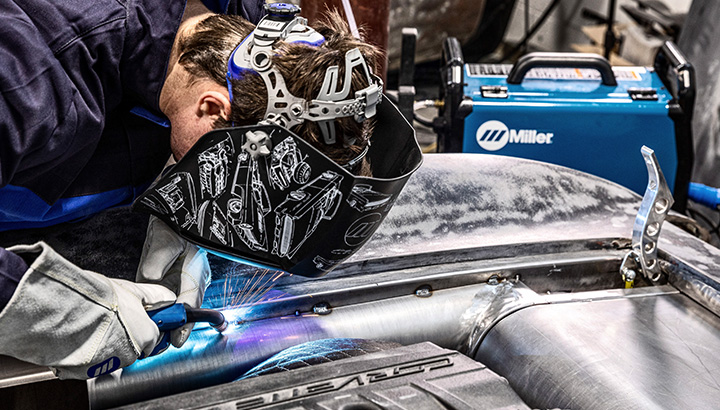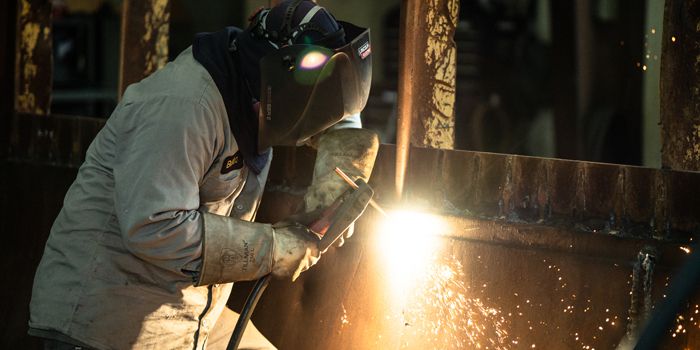Why misalignment happens and how Belgrade Fabrication handles it
Common Welding Repair Service Issues and How to Address Them Effectively
Welding repair work frequently experience an array of problems that can endanger the integrity of the end product. Common troubles consist of inadequate infiltration, porosity, and misalignment, to name a few. Each problem presents unique challenges that call for certain strategies for resolution. Recognizing these problems is necessary for welders intending to improve their skills and results. This discussion will explore these common welding repair service issues and effective methods to address them.
Insufficient Penetration
Inadequate penetration happens when the weld steel stops working to fully fuse with the base material, leading to weak joints and potential structural failures. This issue typically originates from inadequate warmth input, inaccurate electrode angle, or improper welding rate. Welders might experience inadequate penetration as a result of a mistake of the essential specifications for a details product thickness or kind. In addition, contamination on the base product's surface can prevent effective bonding, exacerbating the issue. To resolve insufficient penetration, welders must ensure ideal settings on their devices and maintain a clean work surface area. Normal assessment of welds is recommended to recognize any deficiencies early, permitting prompt adjustments and the avoidance of endangered architectural honesty in welded settings up.
Porosity
Porosity is a common defect in bonded joints that manifests as small gas bubbles trapped within the weld metal. This problem can compromise the stability of the weld, causing decreased toughness and possible failure under tension. Belgrade Welding. Porosity generally emerges from contamination, wetness, or improper welding techniques, which enable gases to escape into the liquified weld swimming pool. To deal with porosity, welders need to guarantee correct surface prep work, preserve a tidy functioning environment, and make use of appropriate welding parameters. Additionally, selecting the right filler material and shielding gas can mitigate gas entrapment. Regular inspection and testing of welds can assist determine porosity early, guaranteeing timely rehabilitative activities are taken, thereby preserving the top quality and dependability of the welded structure
Imbalance
Imbalance in welding can occur from various variables, consisting of incorrect setup and thermal expansion. Comprehending the source is essential for reliable resolution. A number of improvement methods are offered to straighten elements and assure structural honesty.
Sources of Imbalance
Welding misalignment often originates from a selection of underlying issues that can endanger structural integrity. One primary reason is incorrect fit-up of elements prior to welding, which can result in spaces and unequal surface areas. Variants in thermal development during the welding procedure can additionally cause distortion, specifically if the materials being signed up with have various coefficients of growth. Furthermore, insufficient securing and fixturing might stop working to hold parts securely in place, resulting in motion throughout welding. Badly maintained devices, consisting of welding devices and devices, may introduce variances in the weld grain, more adding to imbalance. Operator mistake, stemming from insufficient training or experience, can also play a substantial role in creating misaligned welds.

Improvement Methods Readily Available
Dealing with imbalance efficiently requires a combination of corrective strategies tailored to the certain problems at hand. One typical technique is making use of fixtures or jigs to hold elements in the proper placement throughout welding, ensuring regular placement. Furthermore, preheating the products can help in reducing distortion and enhance fit-up. For substantial misalignment, mechanical realignment techniques, such as utilizing hydraulic jacks or clamps, can be utilized to fix the placement prior to welding. Post-weld warm treatment may likewise be needed to alleviate tensions brought on by misalignment. Mindful inspection and modification throughout the arrangement stage can avoid imbalance problems from coming to be considerable troubles, advertising a smoother welding process and improving total structural honesty.
Distortion
Distortion is a common obstacle in welding that can develop from different aspects, consisting of unequal heating & cooling. Recognizing the root causes of distortion is vital for executing reliable avoidance methods. Addressing this issue not only enhances architectural honesty yet likewise improves the overall top quality of the weld.
Reasons of Distortion
When subjected to the intense warm of welding, products frequently go through modifications that can lead to distortion. This phenomenon mainly occurs from thermal growth and tightening throughout the welding process. As the weld area warms up, the material increases; upon cooling, it acquires, which can produce internal stress and anxieties. In enhancement, uneven heating across a work surface can intensify these tensions, causing bending or bending. The sort of product likewise plays a significant role; steels with differing thermal conductivity and coefficients of expansion may respond differently, resulting in unpredictable distortions. Bad joint design and inadequate fixturing can contribute to imbalance throughout welding, raising the probability of distortion. Comprehending these reasons is essential for efficient welding repair and prevention techniques.
Prevention Techniques
Effective avoidance techniques for distortion throughout welding click now concentrate on controlling warm input and guaranteeing proper joint layout. Preserving a constant warmth input assists to decrease thermal expansion and contraction, which can lead to distortion. Utilizing methods such as preheating the workpiece can likewise lower the temperature level gradient, promoting consistent heating. In addition, selecting appropriate joint layouts, such as T-joints or lap joints, can enhance security and reduce stress and anxiety concentrations. Executing proper fixturing to secure the workpieces in location further help in preserving positioning throughout the welding procedure. Staggered welding series can distribute warm a lot more evenly, preventing localized distortion. By using these techniques, welders can greatly decrease the chance of distortion and enhance the overall high quality of their welds.
Cracking
Breaking is a common issue experienced in welding fixings, usually arising from various factors such as incorrect cooling prices, material selection, or insufficient joint preparation. The occurrence of cracks can considerably endanger the honesty of the weld, causing prospective failures throughout operation. To resolve this issue, welders need to initially assess the root causes, guaranteeing that materials work and properly picked for the specific application. Additionally, controlling the air conditioning price throughout the welding procedure is crucial; quick air conditioning learn this here now can induce stress and cause fracturing. Appropriate joint style and preparation likewise add to minimizing the threat. Carrying out these methods can enhance weld quality and longevity, ultimately decreasing the probability of breaking in finished weldments.

Incomplete Fusion
A significant concern in welding repair services is insufficient blend, which occurs when the weld metal does not properly bond with the base material or previous weld passes - Montana Mobile Welding and Repair. This issue can cause weaknesses in the joint, possibly endangering the honesty of the bonded framework. Factors adding to incomplete fusion consist of inadequate heat input, improper welding technique, and contamination of the surfaces being signed up with. To address this problem successfully, welders need to guarantee proper pre-weld cleansing and surface prep work, in addition to adjust their welding specifications to attain ample infiltration and blend. Routine examination during the welding process can also help recognize insufficient combination early, permitting timely restorative procedures to boost the total quality of the weld
Overheating
While welding repairs can enhance structural integrity, overheating provides a significant difficulty that can result in material deterioration. Excessive warmth during welding can change the mechanical homes of metals, causing lowered strength, boosted brittleness, and bending. This phenomenon is specifically crucial in high-stress applications where structural reliability is critical. Recognizing overheating can entail aesthetic evaluations for staining or distortion, along with checking temperature level during the welding procedure. To minimize the risks related to overheating, welders ought to employ appropriate techniques, such as regulating heat input, adjusting traveling speed, and making use of ideal filler products. Additionally, executing pre- and post-weld warmth treatments our website can aid bring back material buildings and enhance the total quality of the repair work, making certain lasting efficiency and security.
Regularly Asked Inquiries
What Are the Usual Indicators of a Welding Issue?

Just How Can I Test My Welds for High quality?
To check welds for quality, one can utilize visual inspections, ultrasonic testing, and radiographic techniques. Each strategy ensures architectural integrity, recognizes problems, and verifies adherence to defined requirements, eventually boosting the dependability of the bonded joints.
What Safety Precautions Should I Take While Welding?
When welding, one should focus on security by using ideal personal safety devices, ensuring appropriate air flow, securing flammable materials away, keeping a tidy work area, and being conscious of surroundings to stop injuries and crashes.
Can I Fix a Weld Without Renovating the Entire Joint?
Repairing a weld without renovating the entire joint is feasible, depending on the damages (Montana Mobile Welding and Repair Belgrade Welding). Techniques such as grinding, including filler product, or using a welding procedure can efficiently deal with certain flaws while preserving the bordering structure
What Equipment Are Vital for Reliable Welding Services?
Necessary devices for effective welding repair work consist of a welding device, wire brush, grinder, protective gear, clamps, and filler products. Each device plays a vital duty in making certain quality and safety during the fixing procedure. Porosity commonly arises from contamination, moisture, or improper welding methods, which permit gases to escape right into the liquified weld pool. Poorly conserved tools, including welding makers and devices, might introduce disparities in the weld grain, more adding to imbalance. When subjected to the intense heat of welding, materials often go through changes that can lead to distortion. Breaking is a typical issue experienced in welding repairs, frequently resulting from various factors such as incorrect cooling rates, material selection, or poor joint preparation. A substantial concern in welding fixings is incomplete fusion, which happens when the weld metal does not effectively bond with the base product or previous weld passes.